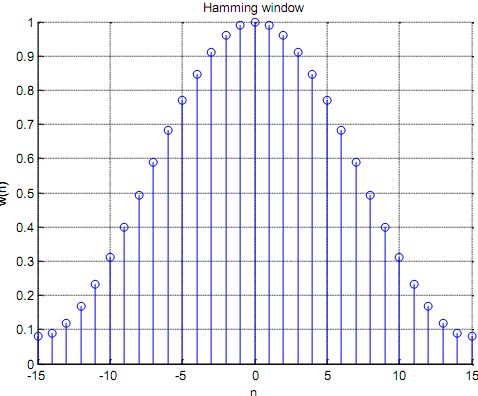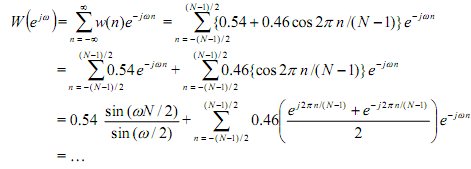The Hamming window described over - (N-1)/2 ≤ n ≤ (N-1)/2 is

%Hamming window defined over n = -(N-1)/2 to (N-1)/2
% w(n) = 0.54 + 0.46 cos(2*pi*n/(N-1))
 N = 31; n = -(N-1)/2: (N-1)/2; wn = 0.54 + 0.46 * cos(2*pi*n/(N-1)), stem (n, wn); xlabel('n'), ylabel('w(n)'); grid; title ('Hamming window')
N = 31; n = -(N-1)/2: (N-1)/2; wn = 0.54 + 0.46 * cos(2*pi*n/(N-1)), stem (n, wn); xlabel('n'), ylabel('w(n)'); grid; title ('Hamming window')
n = -5 -4 -3 -2 -1 0 1 2 3 4 5
w(n) = {0.0800 0.0901 0.1198 0.1679 0.2322 0.3100 0.3979 0.4919 0.5881
0.6821 0.7700 0.8478 0.9121 0.9602 0.9899 1.0000 0.9899 0.9602 0.9121
0.8478 0.7700 0.6821 0.5881 0.4919 0.3979 0.3100 0.2322 0.1679 0.1198
0.0901 0.0800}

The Fourier transform (spectrum) of the window is


The magnitude at dc is

That is computed below for N = 11, 21, 31 and 41:
%Magnitude at DC N = 11:10:41,
WdcN = 0.54*N + 0.46* sin(pi*N./(N-1))./sin(pi./(N-1))
N = 11 21 31 41
WdcN = 5.4800 10.8800 16.2800 21.6800
The width of the main lobe is given as the separation between the zero crossings on both side of ω = 0. This is calculated by setting W (ejw) = 0 and computing for ω; it is provided as
Width of main lobe (Hamming) = 8π/N
twice that of the rectangular window.
Email based Hamming window assignment help - Hamming window homework help at Expertsmind
Are you finding answers for Hamming window based questions? Ask Hamming window questions and get answers from qualified and experienced Digital signal processing tutors anytime from anywhere 24x7. We at www.expertsmind.com offer Hamming window assignment help -Hamming window homework help and Digital signal processing problem's solution with step by step procedure.
Why Expertsmind for Digital signal processing assignment help service
1. higher degree holder and experienced tutors
2. Punctuality and responsibility of work
3. Quality solution with 100% plagiarism free answers
4. On Time Delivery
5. Privacy of information and details
6. Excellence in solving Digital signal processing queries in excels and word format.
7. Best tutoring assistance 24x7 hours